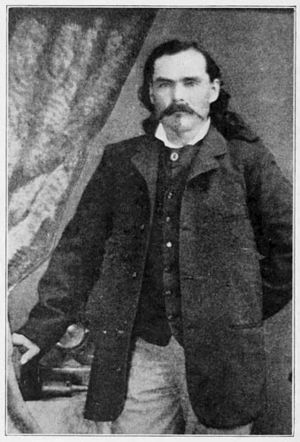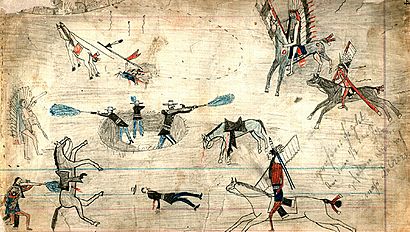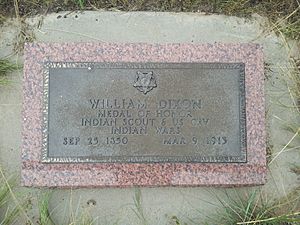Billy Dixon facts for kids
Quick facts for kids
William "Billy" Dixon
|
|
|---|---|

William "Billy" Dixon as an Army Scout
|
|
| Nickname(s) | Billy Dixon |
| Born | September 25, 1850 Ohio County, West Virginia |
| Died | March 9, 1913 (aged 62) Cimarron County, Oklahoma |
| Place of burial | |
| Allegiance | United States of America |
| Rank | Civilian Scout |
| Battles/wars | Second Battle of Adobe Walls Battle of Buffalo Wallow Red River War |
| Awards | Awarded Medal of Honor as a civilian |
| Other work | Hutchinson County Sheriff, Postmaster, and Justice of the Peace |
William Dixon (September 25, 1850 – March 9, 1913) was a famous American scout and bison hunter. He was active in the Texas Panhandle region. Billy Dixon helped start a place called Adobe Walls. He also fired a very famous long-distance shot during the Second Battle of Adobe Walls. For his brave actions at the "Buffalo Wallow Fight," he became one of only eight civilians ever to receive the U.S. Medal of Honor.
Contents
Early Life of Billy Dixon
Billy Dixon was born in Ohio County, West Virginia, on September 25, 1850. He lost his parents when he was 12 years old. After that, he lived with an uncle in Missouri for a year. Then, he set out on his own.
He worked in logging camps along the Missouri River. At age 14, he started driving oxen and mules for a company that worked with the government in Leavenworth, Kansas. Billy Dixon was a very good shot with a gun. Sometimes, he guided people from the East who came by train to explore. In 1869, he started hunting and trapping near Fort Hays in Kansas.
By 1874, he was scouting in Texas. He went as far south as the Salt Fork of the Red River. This was when bison hunters moved into the Texas Panhandle. Billy Dixon and his group hunted along the Canadian River and its smaller rivers.
The Second Battle of Adobe Walls
Billy Dixon led the people who founded Adobe Walls to the Texas Plains. He knew there were many bison there. The group included 28 men and one woman. They lived in a small settlement of five buildings. This outpost was about 15 miles northeast of Stinnett.
On June 27, 1874, a large group of 700 to 1,200 Native Americans attacked the outpost. The fight lasted for three days. On the third day, a group of Native Americans was seen less than a mile east of Adobe Walls. It is said that Billy Dixon borrowed a powerful .50-90 Sharps rifle. He aimed and hit a Native American man who was on horseback from a very long distance.
After this shot, the Native Americans understood how far the guns could fire. They then left the settlement alone. Billy Dixon's shot was measured at over 1,500 yards. This made it one of the longest recorded sniper kills in history. Billy Dixon later said in his life story that it was a "scratch shot," meaning it was a lucky shot.
The Battle of Buffalo Wallow
On September 12, 1874, Billy Dixon and another civilian scout named Amos Chapman were carrying important messages. They were traveling from McClellan Creek to Fort Supply. They were with Sergeant Zachariah T. Woodall and three other soldiers: Private Peter Roth, Private John Harrington, and Private George W. Smith. They were part of General Nelson A. Miles's Sixth Cavalry.
At sunrise, a large group of Kiowa and Comanche warriors surrounded them near the Washita River. George Smith was badly wounded. Soon, Woodall, Harrington, Dixon, and Chapman were also hurt. All of them, except Smith and Chapman, managed to get to a nearby bison wallow by noon. A bison wallow is a shallow dip in the ground, about ten feet wide. They used their hands and knives to dig up the sandy dirt around the edges for protection.
Sitting upright, each man fired carefully. They aimed well and hit a Native American almost every time. Billy Dixon eventually ran to Amos Chapman, whose left knee was badly hurt. Dixon carried him back to the wallow. By 3 PM, a thunderstorm brought rain, which helped them with their thirst. But when the wind changed, it became very cold. This made everyone uncomfortable, especially the Native Americans who sat on their horses out of rifle range.
Roth went to get Smith's gun and ammunition. When they found Smith was still alive, Roth and Dixon brought him back to the wallow. Smith died during the night. At daylight, Billy Dixon went for help. He soon found troops led by Major Price. For their bravery in this fight, which became known as the Battle of Buffalo Wallow, Woodall and the five men with him were awarded the Medal of Honor.
Today, Billy Dixon's Medal of Honor is on display at the Panhandle–Plains Historical Museum in Canyon, Texas. His medal, along with Amos Chapman's, was taken away for a short time. This happened after a review in 1916-1917 said they were not eligible because they were civilians. But in 1989, an Army Board decided to give the awards back. A Texas Historical Marker now marks the battle site.
Later Years and Passing
In 1883, Billy Dixon returned to civilian life. He built a home near the Adobe Walls site. He worked as the postmaster there for 20 years. He was also the first sheriff of the newly formed Hutchinson County, Texas. He served as a state land commissioner and a justice of the peace.
In 1894, he married Olive King Dixon from Virginia. For almost three years, she was the only woman in Hutchinson County. They had seven children together. In 1902, the family moved to Plemons so their children could go to school. In 1906, they moved to Oklahoma.
Billy Dixon died from pneumonia at his home in Cimarron County in 1913. He was buried at the Adobe Walls battle site in Hutchinson County, Texas. Before he died, he told Olive his whole life story. She wrote it down and later published it. In 1929, his body was moved and reburied at Adobe Walls.
Dixon Creek in southern Hutchinson County is named after him. The Billy Dixon Masonic Lodge in Fritch is also named for him. A special plaque honoring his Medal of Honor was placed in 1992.
The Historical Breechloading Smallarms Association in England holds a shooting competition to remember his amazing long-distance shot. It is called the Vintage Rifle Open Long Range Championships. Shooters from all over the United Kingdom compete at 1,000 yards using old-style rifles from Billy Dixon's time.
See also




